MODELING OF THE THERMOGASDYNAMIC, HUMIDITY AND RADIATION STATE OF THE NEW SAFE CONFINEMENT OF THE CHERNOBYL NPP, AS WELL AS THE SPREAD OF RADIOACTIVE AEROSOLS INSIDE AND OUTSIDE THE NSC
Models of the physical state of the New Safe Confinement (NSC) (Fig. a) built over the Shelter Object (OS) and the destroyed Unit 4 of the Chernobyl Nuclear Power Plant with a lifespan of 100 years for the transformation of the OS and the reactor into an environmentally safe object were created. Its dimensions are 110m high, 250m wide and 165m long. To ensure a 100-year resource, the NSC has special ventilation systems to maintain humidity no more than 40%. The NSC is not hermetic, therefore, in order to reduce the release of radioactive aerosols (RA) into the environment (OS), the ventilation system must constantly maintain a pressure of 5-8 Pa less than the external one.
To analyze and predict the general gas-dynamic (Fig. b), thermal (Fig. с) and humidity (Fig. d) and radiation (Fig. e-f) states of the NSC, appropriate models were developed to analyze, optimize and predict the operation of the NSC ventilation system at various climatic conditions and failures of ventilation equipment.
Thermogasdynamic and Humidity State of the NSC
The model of gas-dynamic interaction between the NSC and the Environment (Fig. b) makes it possible to determine the pressure distribution on the NSC surfaces and the NSC air exchange with the Environment, which determines the unorganized release of RA into the Environment. The thermal state model (Fig. c) makes it possible to determine detailed moisture distributions for the locations of load-bearing building structures in the NSC (Fig. d) in order to prevent moisture exceeding 40%.
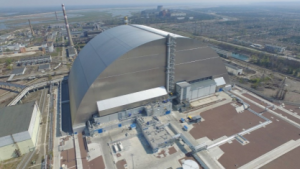
a |
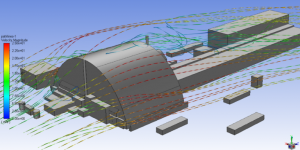
b |
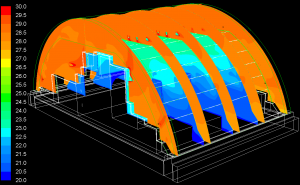
c |
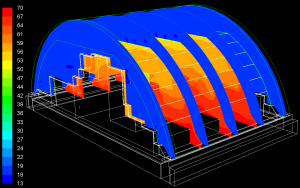
d |
Radiation state of the NSC
Models of NSC radiation state (Fig. e-h) make it possible to determine the distribution of RA in the NSC volume during the extraction of fuel-containing materials from the Object Shelter (Fig. f), the spread of RA in the NSC volume during collapses of unstable Object Shelter structures (Fig. e-f), fires at the roof of the turbine hall (Fig. g) and the leakage of RA into the environment (Fig. h).

e |
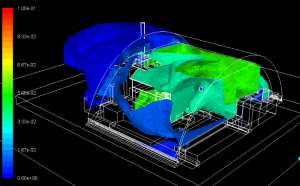
f |
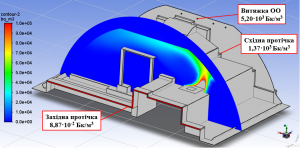 g g |
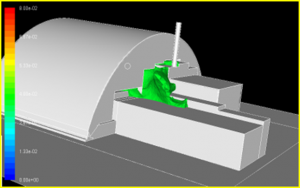 h h |
The developed models of the thermogasdynamic, humidity and radiation state of the NSC have no analogues in the world and were carried out with the financial support of:
- VINCI Construction Grands Projets/Bouygues Travaux Publics – NOVARKA (2010-2019).
- National Academy of Sciences of Ukraine – “Improvement of methods and models for analysis and forecasting of the thermogasdynamic state and radiation pollution of ground and underground facilities during fires and accidents” (2014-2019).
- NATO Science for Peace and Security Programme “REDEFINED CHERNOBYL CONFINEMENT MODEL – ASSISTING UKRAINE IN MANAGING THE RADIOACTIVE DUST DISTURBANCES AND LEAKS AND PROTECTING THEIR WORKERS (2014-2017)”.
- Chernobyl nuclear power plant
Commercial offer.
Development and application of models for analysis, prediction and optimization of thermogasdynamic, humidity and radiation conditions of aboveground and underground objects under normal and extreme conditions
Рublications
- Pysmennyy, Y., Havrylko, Y., Krukovskyi, P., Starovit, I., & Diadiushko, Y. (2022). Development of Mathematical Software for Control of Ventilation Equipment in the New Safe Confinement, (2(94), 35-43. https://doi.org/10.32918/nrs.2022.2(94).04. Scopus Q3.
- Krukovskyi P., Diadiushko Ye., Skliarenko D., Starovit I. Unorganized air releases with radioactive aerosols from the new safe confinement ChNPP into the environment (operational data modeling). Problems of atomic science and technology, №6, 2021. p.56-82. Scopus, Q3.
- Krukovskyi P., Oliiyk V., Metel M. 3D CFD model of thermogasdynamic state of the New Safe Confinement of Chernobyl NPP // International Journal of Mechanical Engineering, Vol. 3, 2018, p. 109-118. ISSN: 2367-8968. Scopus.
- New Safe Confinement of Chernobyl NPP (calculation-experimental analysis during design and operation): monograph/ Krukovsky P.G., Metel M.A., Sklyarenko D.I. et al; Edited by P.G. Krukovsky, V.A. Krasnov, V.P. Sulimov/ Kiev, LLC “Franko Pak”, 2019 (In Russian). – 300с. ISBN 978-966-97864-7-0.
